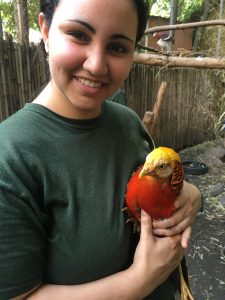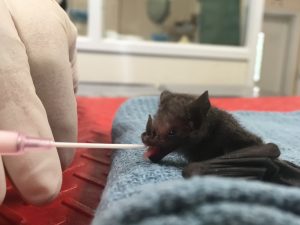
Mary restraining a golden pheasant during a series of wellness checks and blood draws completed on a variety of exotic chickens and pheasants.
A day in the life of a zoo veterinarian: a fer de lance cardiac consult, thirty outtake exams and blood draws on various breeds of chickens and pheasants, and a recheck on a Pacu fish with abrasions and missing scales. During the summer of 2017, I interned at the Staten Island Zoo: New York’s Biggest Little Zoo. I worked with amazing people and learned many valuable lessons. I medicated snakes via gavage tubes, practiced darting using a target board, and appreciated the vast differences between zoo and companion animal medicine. While many of the same principles are used, the tactics and methods of implementation differ because the animals that we deal with in zoo animal medicine are dangerous, wild, easily stressed, or some combination of the three (usually all three).
This summer, I learned the importance of understanding animal behavior in zoo medicine. Reading behavioral signs to infer how an animal is feeling and predict how it may react is integral to proper animal management, housing, efficient medical treatment, and many other contexts. In a small animal setting, a scared or aggressive dog can inflict a severe bite wound. Irritation and loss of patience in a full-grown male ostrich, on the other hand, can lead to severe injuries such as broken bones, spinal injuries, or even death. We pay attention to these cues and don’t take them lightly, for safety reasons. Additionally, understanding animal behavior allows us to influence that behavior, and train animals to perform certain behaviors on cue. Training can be utilized to facilitate interactions with and evaluate larger and more dangerous animals on a regular basis without anesthetizing them, which is important for wellness checks and physical exams. It also allows the public to interact with animals in a more close-up setting, during education programs with ambassador animals.
For zookeepers and the zoo veterinarian, the first step in understanding animal behavior is recognizing a change from what is considered normal in that species. Animals do their best not to appear ill, which makes it difficult to recognize a problem early on. This especially rings true for animals in the wild, since predators target the visibly weak or ill prey for their next meal. But subtle changes in behavior – namely, depression – can be an early indicator that something is wrong and allows for earlier diagnostics and intervention. This summer, an otherwise healthy-looking chuckwalla was not standing at attention with her neck and head extended, as many lizards normally do. Instead, she was sprawled out on her belly. The ability to recognize this behavior as abnormal prompted us to draw a blood sample, and ultimately diagnose and treat anemia.
Understanding animal behavior is also critical in a captive setting to decide which animals are housed together. Animals, just like humans, have complex social interactions and develop social hierarchy systems. New animals must be introduced to a group slowly, to prevent disruptions in social structure which could lead to fights that result in injuries. This summer, two female Kenyan Crested Guineafowl were brought to the Staten Island Zoo for breeding and were to be housed in the same enclosure as the two existing males birds at the zoo. The new members were left in their carriers within the exhibit for a few hours to allow the birds to interact through the bars, before they were given full access to one another. Similarly, after removing a Gambel’s quail from its group for several days for treatment of a leg injury, we separated the large group into two smaller groups. Because the birds were reestablishing their social hierarchy, reintroducing the previously injured bird as part of a group of three reduces the chances that she will be targeted during these fights.
Successfully introducing dangerous animals to one another must be done cautiously, particularly when the animals are endangered. The Staten Island Zoo recently acquired a new female Amur leopard, Liski, as a breeding partner for the resident male, Kolya. The entire introduction process was done slowly and carefully, since the animals can easily harm one another and their caretakers. First, the leopards exchanged enclosures at night, in order to pick up the other’s scent. Then, they were allowed to interact through the fencing. These two steps occurred over the course of several weeks to ensure Liski adjusted well fully introducing the two leopards to one another. Liski and her trainer worked closely multiple times a week, and over time, we learned more about her as an individual animal and better understand her personality.
On the day the two leopards were first introduced, we gathered several keepers, interns, and the vet together, instructing each person to watch the two animals very carefully. The room was full of excitement; every person was on their toes. They were given about 5 minutes to interact that first day before being separated once more. We allowed the leopards to repeat this interaction three times a week, for several weeks – and each time, we increased the length of time that they were allowed together. By the end of the summer, the two leopards were allowed on exhibit together, respecting each other’s space. Each animal even has their own “favorite spot”.
If understanding behavioral cues is important in our day to day interactions with one another as humans, it is so much more important when interacting with animals, since there is a literal communication barrier. It is even more important when working with non-domestic animals, since they often view humans as a threat to their well-being. The many cases I have seen last summer have illustrated how understanding behavior impacts the success of treatment, while simultaneously keeping animal staff out of harm’s way. I am grateful to have had this experience, not simply because I’ve worked on improving my clinical and handling skills with a large variety of species, but also because I’ve learned more about the subtleties involved in zoo medicine.
ABOUT THE AUTHOR
Mary Nasr is a second year vet student from Staten Island, NY. She received her Bachelor of Science from Rutgers University in 2016, with a major in Animal Science. She is passionate about zoo and wildlife medicine, conservation, and education, and aspires to build a career around zoo/wildlife surgery and anesthesia.



